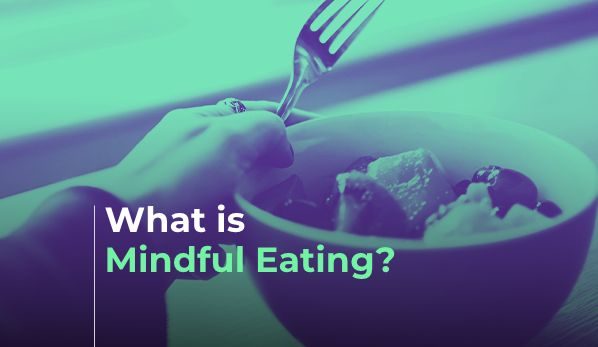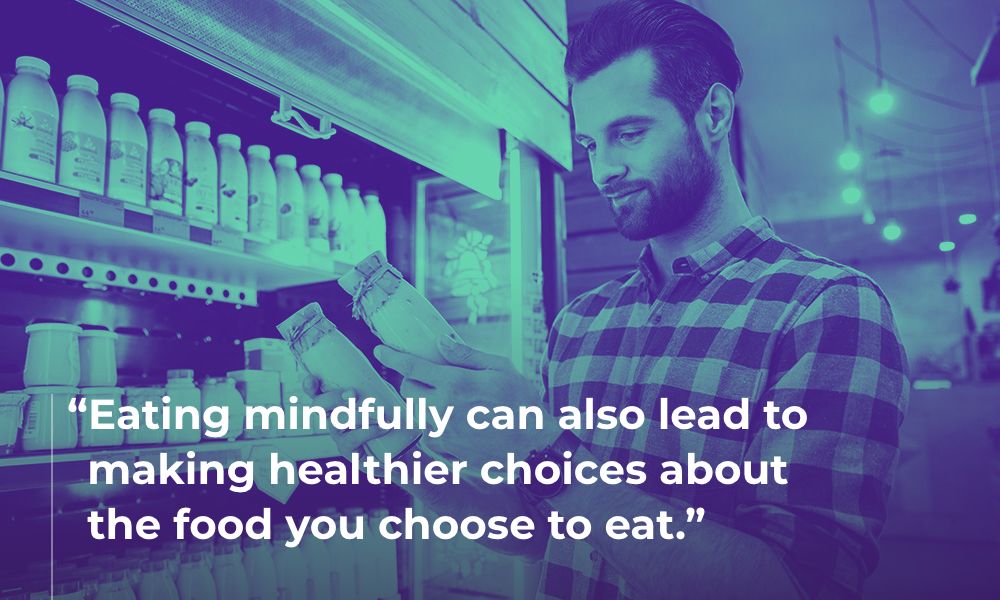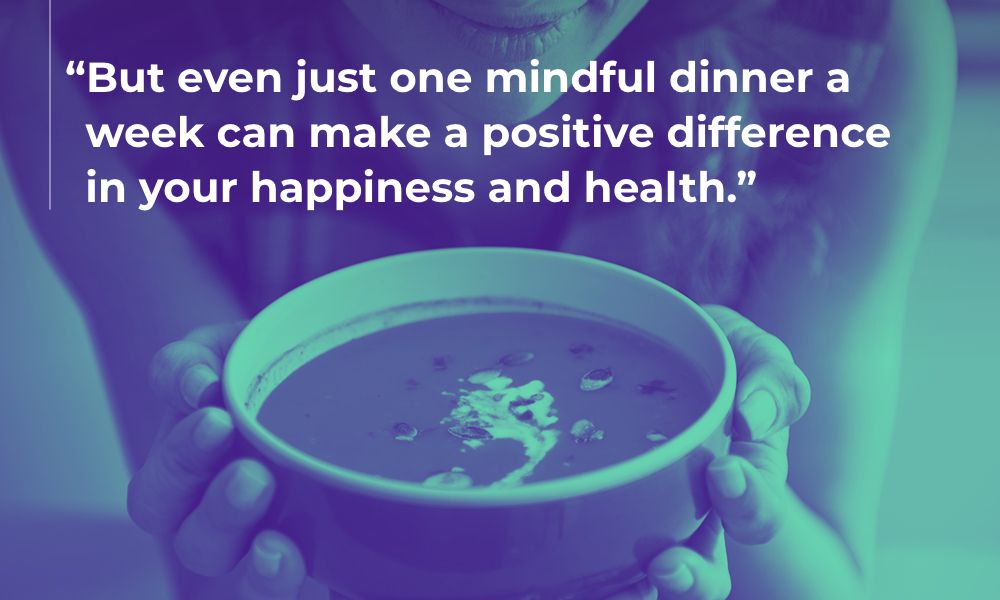Mindful eating is the practice of eating food with awareness and intention. When you eat mindfully, you notice the texture, aroma and taste of the food. Mindful eating can lead to improved physical and mental health. Plus, it can help you make better choices about the food you consume.
Keep reading to learn all about mindful eating and how to do it. We also explain how this practice differs from intuitive eating. And we discuss how you can explore your relationship with food through practicing mindfulness. Let’s dig in.
Mindful Eating vs. Intuitive Eating
At first blush, mindful and intuitive eating may seem the same. They do share some key characteristics, but they’re two different practices.
Intuitive eating is a process of learning to trust your body’s own physical hunger signals. This practice relies on your own inner wisdom rather than relying on a prescribed diet. It asks you to differentiate between when your body is truly hungry and when you desire food as a way to distract from coping with your emotions.
Intuitive eating has several tenets, like allowing yourself to eat when you’re hungry and stopping when you’re full. It also suggests that you listen to what your body wants to eat. It encourages you to eat nutritious foods but doesn’t make you adhere to a strict diet.
Mindful eating is the process of giving your full attention to the sensations of the food you’re consuming. Often, mindful eating can help satisfy some of the tenets of intuitive eating. For example, when you eat mindfully, you realize and respect when you’re genuinely full.
The opposite of mindful eating is mindless eating. Mindless eating is when you eat while giving little or no attention to your food choices or to what you’re consuming. Many of us do this when we watch television or scroll on our phones while we eat. Naturally, mindless eating is also not encouraged for those looking to eat intuitively.
The Benefits of Eating Mindfully
Mindful helps you be more present. And studies show that being present makes you happier and leads to better overall health.
But there are also some benefits specific to mindfully eating. For instance, mindful eating can improve your digestion. This may lead to fewer unpleasant symptoms, like heartburn and bloating in the gut, after eating your favorite foods. Mindful eating can also help you realize when you’re full, which over time can help you healthily lose weight.
Eating mindfully can also lead to making healthier choices about the food you choose to eat. After all, it’s harder to ignore the damaging effects of greasy potato chips once you’ve shifted your full focus onto eating them.
Steps for Practicing Mindful Eating
Are you ready to get started with mindful eating? Here are some helpful steps for doing it with your next meal.
- Turn off all distractions, like social media or television.
- Take a couple of minutes to do a breathing exercise before you begin eating. This will help reduce stress, focus on your meal, and increase anticipation for your first bite.
- Focus all of your attention on your food. Think about all of the things that had to happen for your food to arrive on your plate.
- Begin to engage all of your senses. What does your food look like? What aroma does it have? Notice the vibrancy (or lack thereof) of its color.
- Take a bite. What does it taste like? What’s the texture? How does it feel in your mouth?
- Fully chew your food before swallowing it. Pay attention to the physical sensations involved in this process.
- After the first bite, put down your eating utensil. Continue to put down the utensil after each bite of food.
- Wait until you’ve swallowed the first bite before starting the next.
- Listen for when you’re full. Once you’re full, stop eating; don’t just eat until your plate is empty.
- Sit down to eat your meal. Eating standing up or on the go makes it difficult to eat mindfully and can hinder your digestion.
Tips for Getting Started with Mindful Eating
Eager to get started with mindful eating? If you’re feeling intimidated or frustrated, that’s normal. Making a big lifestyle change requires time and dedication. Here are a few tips to help you prepare for the challenge:
Tip #1 Embrace the Challenge
Mindful eating can be difficult for beginners, and that’s okay! You’ve likely spent a lot of your life eating with distractions and feeling disconnected from your food. So drawing attention to your meal in the present moment can evoke a lot of different feelings.
You may feel bored, or like you’re wasting time. Or, you may feel overwhelmed or have some anxiety. Whatever you feel is A-okay. Simply observe it without judgement and continue mindfully eating. Don’t forget to be gentle with yourself.
Tip #2 Make the Time to Eat Mindfully
It isn’t easy to be a mindful eater when you’re eating in a rush. Where you can, set aside time in your schedule just for a mindful meal. It’s alright if you don’t have time to do this for every meal, especially at first. But even just one mindful dinner a week can make a positive difference in your happiness and health. Start with one and build up from there.
Tip #3 Incorporate Mindfulness Tactics Every Time You Eat
We get it—sometimes a hurried sandwich eaten at your desk is the best you can manage on a busy workday. And it’s hard to get meditative when you’re inhaling a granola bar while driving down the freeway. There’s no need to shame yourself for not doing a complete mindful eating practice when these things happen. Instead, just incorporate one or two mindfulness tactics where you can.
Take one long, slow breath all the way into your stomach before eating that granola bar. Or close your eyes for just 30 seconds to check in with your emotions before you bite into that sandwich. Even if you spend the rest of your lunch multitasking, these small mindfulness triggers can still make a big difference.
Tip #4 Share Mindful Eating with Family and Friends
It can be difficult to eat mindfully when the rest of the family wants to watch a movie with dinner. So, see if you can get your friends and loved ones to join you in your quest toward mindful eating. Little ones might be more eager if they get to help with food selection and cooking.
If your loved ones are not ready to join you, that’s okay. Chances are they may be ready after they see how much you benefit from your practice.
Those are some of the most effective tips for getting started with mindful eating. But you may need some more tips to help you as you continue on your journey. Here are a few other pointers to remember when practicing mindful eating:
- Avoid eating food straight from the packaging. Portion it onto a plate instead.
- Choose dishware in colors and styles that you enjoy. This is a form of visual nourishment!
- Sit down to eat your meal; don’t eat standing at the kitchen counter.
- When you feel hungry, check in with your emotions to ensure you’re not eating out of boredom, sadness, or another unpleasant feeling.
- Permit yourself to eat when you’re hungry. Honor your appetite, even if it’s not at a conventional meal time.
- Take note of how you feel before you begin and after you finish eating your meal. (No need to judge these feelings; simply notice them.)
- Tune in to the flavor of the food you’re eating. Really savor it. See if you can pinpoint the various ingredients that went into the dish.
- Eat in silence or play calming music while you eat.
- Schedule time to sit down for breakfast, lunch, and dinner. Treat it as a meeting, and don’t use that time to multitask.
- Eat before you’re overly hungry.
- While it’s important to eat healthy foods, try to choose ones you enjoy. There’s no need to force yourself to eat a type of vegetable you hate when there are other types you love.
- If you choose to indulge in less-than-healthy food, do it with joy rather than stress. Your experience of food can be positive, even when the food isn’t nutritious.
Exploring Your Relationship with Food Through Mindfulness
It can be easy to forget the impact that our eating habits have on us. But we are becoming more and more aware of just how integral nutrition choices and the experience of eating are to our mental and physical health.
This includes more than just the type of foods you consume. It matters how you eat them too. Eating a meal while you’re stressed, for example, can cause you to eat too much. This can lead to overeating problems like obesity and diabetes.
It’s worth considering, then, how we can become more in-tune with our eating behaviors. Mindfulness is the best way to do that. It encourages us to become aware of the choices we make before, during, and after eating. It allows us to eliminate distractions while we eat. Mindfully eating reminds us to honor our time with the food. And it helps us choose food options that our bodies need and not ones that our emotions say we want.
Remember that judgment isn’t the goal here; we simply want to observe and learn from our choices. You may get some interesting insight!
Mindfulness meditation is an excellent way to cultivate your mindfulness skills. It can help you improve your relationship with eating, as well as live a more mindful life. We recommend using a meditation app like Primed Mind for a quick and easy start to your meditation practice.
Primed Mind is free to download and features primers (audio recordings) designed to help you start eating mindfully. Enjoy a deep primer on “Nailing Your Nutrition Goals” or a power primer to “Relax During Your Lunch Break,” and see how it translates to more mindful choices at mealtime.





